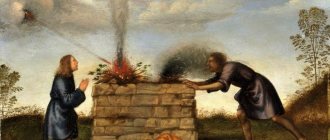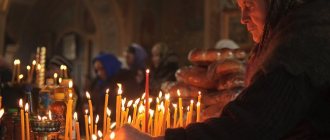What should be in the temple
In short, there is only one mandatory requirement in the way the temple is structured. Or rather, this is not even a requirement, but precisely for the sake of which the entire temple is erected: the Throne in the altar on which the Liturgy is celebrated. If there is no throne, then it is a chapel.
Everything else that we see and are accustomed to seeing in the temple is either self-evident things, or things that have developed over centuries and become a tradition.
For example, icons in a temple are a given. A temple will not cease to be a temple if there are no icons in it, but it would be strange to invest in the construction of a church and not place icons in it. It’s strange for a Christian to generally avoid icons, so any Orthodox church will have icons. And the more there are, the better: it means there will be more prayerful memory of the saints before the eyes of people.
The same thing is the cross on the temple. Liturgies were served in destroyed churches, in caves, and simply in conditions when Christians were not allowed to preach (for example, during the Muslim yoke). But when there are no prohibitions, it is strange not to proclaim with a cross on the roof of a building that this is a temple, the Holy Spirit is here, the Liturgy is here. That's why there are crosses above all Orthodox churches.
“Traditional” things can include what we are accustomed to specifically - in the Russian Orthodox Church - but in other countries the same thing may have completely different forms or be completely absent. For example, temple architecture. Or the presence of an iconostasis in the form of a “solid wall”. Or candlesticks near icons.
We will definitely talk about the architecture of churches separately, but in this text: about how an Orthodox church is arranged inside.
Symbolism
Photo: Sobory.ru
The throne plays a big role in Orthodoxy. It is believed that this is the place of the mysterious and invisible location of the Savior. For this reason, only priests are allowed to stand in front of him, much less touch him.
Several symbols associated with them in the Orthodox tradition should be noted:
- The throne has four sides, which represent the cardinal directions. In addition, the four sides of the throne symbolize parts of the day, seasons and tetramorphs (these are creatures known from the described visions of John the Evangelist).
- The 4-cornered shape of the throne represents the four Gospels.
- Finally, it is a symbol of the Holy Sepulcher.
If a ciborium (canopy) is placed directly above it, personifying the sky, then the throne itself becomes a symbol of the earth where the Savior descended to atone for the sins of mankind. Usually on the ciborium there is an image of a dove, representing the Holy Spirit.
Altar in the temple and throne
As we have already said, the throne is the only, in fact, obligatory part for the temple, since for the sake of the Throne and around it the temple is built. The consecrated altar itself makes the room a temple. In the place where the Throne is, a person himself should rejoice and tremble - in memory of the boundless Love of God and His earthly path.
In the first centuries of Christianity, tombs containing the relics and remains of saints or martyrs served as altars. Now this tradition has been preserved, but has changed: in the altars of churches there are no coffins, but still the throne must be consecrated by the ruling bishop and have a reliquary with a particle of the relics of some saint. Only in this case can the Liturgy be celebrated on the Throne!
The presence of the Throne implies that there is also an altar - the holy of holies of any temple. According to tradition, only temple servants can enter the altar, or with the blessing of the abbot.
Patriarchal service. photo: patriarchia.ru
Evolution of the throne
Photo: Kamensk-eparhiya.ru
In early Christianity, thrones were portable, and wood or stone was used to make them. Their location in the church was confirmed in the 4th century. Since then, they have primarily been made from stones. Outwardly, they look like low tables with four legs, which were placed inside the altar, where ordinary believers are prohibited from entering.
Over time, to replace the standard four legs, the throne began to be made on one; another alternative option was to make a solid stone base. Since the beginning of the 10th century, a tradition that has become established over time has emerged to place the altar directly in the very center of the altar.
From the 15th century, thrones began to be made of wood or made in the form of impressive stone monoliths. They had a lid at the top; it had to be covered with a special cloth.
Iconostasis in the temple
The iconostasis separates the altar from the rest of the temple. This is not a “rule” or a canon - a temple will not cease to be a temple without an iconostasis, but it is a natural and, probably, the only opportunity to protect the Holy of Holies from worldly everyday vanity and behavior unworthy of the shrine - for example, a tourist in shorts and with a camera, behaving in a -in-laws.
In fact, this is a reasonable tradition that has become “mandatory”.
In fact, the task of the iconostasis is not so much to separate the altar as to serve people as a “window to heaven” and as a prayer aid. So that the parishioners, in the end, do not get distracted and do not pay undue attention to those actions in the altar, which, unlike the Sacraments, do not need to be given attention. For example, the priest explains to the young altar server at what moment to leave the altar with the candles: this is an absolutely “working” moment that will captivate the parishioners in a completely unnecessary way.
Temples without iconostases are found only in exceptional cases - if the temple is just being built or arranged in “camping” (temporary) conditions.
Most often in our Orthodox churches it is a “solid wall” with icons - that is, it completely hides the altar, and you can see “what is there” only at those moments of the service when the gates are open. Therefore, in large churches or cathedrals, the iconostasis can be as tall as a multi-story building: it is majestic and beautiful. Such iconostases are decorated with several rows of icons depicting the apostles, the main Church Feasts, the Savior, the Mother of God...
Iconostasis of the Trinity Church of the Moscow Compound of the Holy Trinity Sergius Lavra. Photo: blagoslovenie.su
But in some churches the design is simpler: the iconostasis does not completely hide the altar and behind it you can see both the clergy and the Throne itself. The idea of such iconostases is, on the one hand, to enclose the Holy of Holies, but on the other, not to separate the parishioners of the Great Sacrament: so that the Liturgy is not only intimate and majestic, but also a common action for the entire Community.
Relics
Photo: Foma.ru
In most modern cathedrals and churches, the relics of saints are placed directly under the altars. This tradition appeared many centuries ago; it was officially designated at the Ecumenical Council held in the 7th century. Since then, placing the relics in the altar has been considered one of the mandatory traditions that must be observed during the consecration of the temple.
It is customary to place the relics at the base of the throne or place them in a hole specially designed for this purpose.
There may be several altars in a temple
If the size of the temple allows, then they try to make two or three altars in it, but in principle there can be as many of them as desired (for example, in St. Basil’s Cathedral on Red Square there are 11 altars and thrones).
Why do you need several altars?
There are two reasons. One is purely canonical. According to the establishment of the Church, during the day only one Liturgy can be served on one altar (and therefore in one altar). On major holidays, the Liturgy in one church can be served twice or even three times (for example, on Easter). For such cases, several altars are designed.
Zosimova Hermitage near Moscow in Rassudovo. Main temple. In the frame you can see the central altar and a little further - another one.
The second reason: “ideological” and it is, as it were, “added” to the canonical one. For example, the founder of the temple, city or monastery where the temple was erected may have especially revered saints or holidays. Altars are consecrated in memory of them, and liturgy is served there on appropriate holidays.
Of course, the number of altars is thought out at the project stage.
Altar structure
From this, the most important part, the construction of any temple begins. Architects say that the shape, decor, even the radius of the altar and the main dome of ancient churches most often coincide. This is not accidental: after all, the temple is a single ensemble, Heaven on earth, and its heart is where the throne is.
Where is?
As you approach the temple, you will notice one or more semicircular projections. They are called apses, and are made for the altar. From them you can see how many altars the temple has - for example, a three-altared one usually includes three apses - a central, larger one, and two smaller ones on the sides. Inside the church, the location of the altar is also easy to determine by the iconostasis - several rows of holy images. They hide a sacred place. The so-called “royal doors” lead inside, and two others – northern and southern, called deacon’s.
Why in the east?
As a rule, temples are oriented in such a way that the first rays of the rising sun fall on the throne. The tradition is usually associated with the fact that in the east, according to the Book of Genesis (Genesis 2:8), Paradise is located:
“And the Lord God planted a garden in Eden in the east, and there he placed the man whom he had created.”
However, the tradition did not develop immediately, not everywhere:
- Thus, the Roman Cathedral of St. Petra, built on the site of a 4th- century basilica, faces west; Pope Benedict XVI, in his book “Theology of the Liturgy,” explains precisely the Catholic tradition when the priest during Mass prays “versus populum” (“facing the people”), that is, to the east, and not to the throne; the very orientation of the cathedral is usually explained by the specifics of the terrain, and, apparently, by the fact that the tradition of praying to the east developed from the first centuries, but the rule of the same orientation of the altar appeared later;
- “violations” of the currently accepted custom also exist on the territory of Russia, where churches of the first centuries after the Baptism of Rus have been preserved; for example, the churches of Pskov, as well as its immediate surroundings until the 14th century. were turned not to the east, but towards the sacred heart of the city - the Kremlin, where the Trinity Cathedral, founded by Princess Olga, stands; many of these churches have survived to this day and are active, although their location does not coincide with the traditional one.
The current church of St. Nicholas near Pskov. Her altar is not oriented to the east. Photo by the author of the article, July 2011 9.30 am, you can see from the shadows where the sun is.
What does the sacred altar look like: description
The peculiarity of this part of the temple is that it is at some elevation in relation to the nave (where worshipers gather) and the vestibule (the western part of the church).
What's there
Now it's common here:
- the throne is a mandatory accessory of the temple from the first centuries of the Church;
- altar;
- the bishop's chair, which is located on the so-called High Place - opposite the throne at the very eastern walls;
- sacristy.
Throne
This is part of the altar, known since the times of the Ancient Church. Initially, the sacrament of the Eucharist was performed directly on the stone tomb of the martyr, which served as a throne. This is where the custom of later churches came from to have a particle of the relics of saints in the altar. It was finally established in the 8th century.
Throne and canopy over the throne of the Assumption Cathedral of the Moscow Kremlin
The relics are also enclosed in a special plate located on the throne, in Greek called “antimens” (the word literally means “instead of the throne”). On such a board, the liturgy can be performed even outside the church.
There is evidence that during the persecutions of the Soviet years, imprisoned priests more than once served the liturgy literally on the relics - on the chest of a martyr dying of hunger, overwork. Here is the story of a witness to such services, Archimandrite Tavrion :
“How did they serve without an antimension, without a throne? One priest lay down, and the rest served on his chest. Instead of prosphora - bread. The Lord said at the Last Supper that the bread is transformed into His Body. And instead of wine - water. In Cana of Galilee, the Lord turned water into wine. And we all took communion. They were happy and cheerful! With God there is no loss anywhere!”
Nowadays the throne can be made of wood or stone. The wooden throne is covered with brocade vestments. A stone vestment may not have fabric: vestments for it are often made of expensive metal, decorated with precious stones.
Throne
The throne of the Church of Hagia Sophia in Constantinople had such vestments. And its top board was made of pure gold interspersed with precious stones.
On top of the vestments of the throne are placed:
- antimins;
- Gospel;
- cross.
In addition, on the throne there is a Tabernacle and a lamp.
Altar
Now this is the name given to the northern part of the altar space, as well as the table itself, on which the sacred vessels for performing the main Sacrament are located. Here, before the start of the liturgy (during the reading of the Hours), the priest performs Proskomedia, preparing sacrificial bread for the Eucharist.
This arrangement of the altar is a later one, established as a widespread custom no earlier than the 6th-8th centuries.
Interesting fact
The modern liturgist,
R. Taft , an expert in Byzantine worship, managed to establish that in the church of St.
Sophia of Constantinople, the most famous cathedral of the Christian world, liturgical vessels were located not only outside the temple itself, where there was a special room called skevophilakia. When the time came for the Sacrament, a procession of clergy was sent from the altar. Having taken the vessels, the priests and deacons returned just as solemnly. At the same time, the believers asked their prayers for themselves, to which the priests replied: “May the Lord remember you all in His Kingdom!” This is how the custom now called the Great Entrance originally arose. Subsequently, it received a theological interpretation, symbolizing the procession of Christ to Calvary.
Department
The exact name of this part is “ἡ ἄνω καθέδρα”, or “upper pulpit”. In Slavic it is also called the Mountain Place. There is a special chair here, usually richly decorated. This is the place of the Lord, seated among His disciples. If the church is a parish church, a lamp is always burning on the High Place, signifying the invisible presence of Jesus Christ. In the cathedral it is occupied by the bishop during services.
Quite often the Mountain Place is located quite high. Initially, when the altar had a low barrier, it was more convenient for the bishop to deliver sermons from the High Place, rising above the space of the temple. Subsequently, the symbolism of the steps leading upward was rethought: now it is more a symbol of the throne of God. When the bishop ascends to the pulpit, his exclamation “Peace to all” clearly recalls Christ’s last blessing to the disciples before His Ascension.
Near the High Place there are also benches for the clergy, where they sit during some moments of the service.
High place in the altar
Sacristy
This is the southern part, otherwise called the diakonnik. The vestments of priests and other ministers, as well as liturgical books and other items are stored here.
At least until the 16th century. in Rus', the sacristy was also called “kuteinik”, from the name of the traditional dish served at funerals. After all, according to the ancient Russian tradition, it was here that parishioners brought candles and notes about the repose of their relatives. They also carried food that is now customary to be left on the funeral table.
Interesting fact
Only in 1551 did the Council of the Hundred Heads prohibit the bringing into the altar of anything other than bread and wine used during divine services. However, for a very long time the tradition of burying benefactors and noble parishioners was preserved here.
Thus, in the sacristy of the Archangel Cathedral of the Moscow Kremlin there is the grave of Ivan IV , as well as his sons Ivan and Theodore.
Rise in front of the altar
Firstly, this is the so-called soleya; it stretches across the entire width of the iconostasis. Initially, it was needed so that the service could be better seen and heard by all parishioners, even those standing far away. The center of the solea is a semicircular protrusion exactly in front of the royal doors, called the pulpit. Scripture is usually read from it and sermons are delivered.
Interesting fact
Historically, the pulpit did not always have a low height - in large cathedrals it could rise even to several meters, and look like a small tower. For example, above the high pulpit of the Church of St. Sophia of Constantinople had a canopy with 8 columns, and a high staircase led up. According to the recollections of contemporaries, its construction took the annual budget of one of the Byzantine provinces - Egypt.
Such pulpits, of course, were not protrusions on the sole: they were placed in the center of the temple. Antiphons were sung from them and sermons were read. The royal wedding took place on the pulpit.
Icons in the temple
Icon from the iconostasis in the Georgian Cathedral in Mtskheta
An Orthodox church cannot be imagined without icons. Even the poorest rural church tries to have plenty of them - even in “printed” form.
Icons - that is, images of saints and Church holidays painted according to special rules - are present in churches in the following forms:
- Icons on the walls.
These are the icons that, so to speak, are most accessible to parishioners. They are applied to them, candles are placed in front of them. - Temple painting
(frescoes). - Icons on the iconostasis.
- Icons taken out on occasion
(for example, icons of saints that are placed in the center of the temple on the lectern on the days of the corresponding holidays). The point is not that these icons are hidden somewhere in order to give “access” to them once or twice a year, but that the space of the temple is limited and there is simply not enough space for all the icons.
Icon of the Holiday on the lectern. Photo: blagoslovenie.su
Story
For many centuries, people, trying to return the Kingdom of Heaven, lost after the fall of the first people Adam and Eve, built temples, and in them altars, as they thought, to the gods, but in reality - to lower spiritual entities, fallen angels. Although the man’s impulse was fundamentally noble, the sinful damage to his spiritual vision led to the fact that the words of the Apostle came true over many:
“I don’t understand what I’m doing: because I don’t do what I want, and what I hate, I do.”
(Rom.7:15).
Serving the True, Living God was performed by only one people - the Jews.
Among the ancient Jews
For the first time, the “Holy of Holies,” the place of the real presence of God, appeared in the Tabernacle, a camp temple built by the prophet Moses immediately after the Jews left Egypt. In this specially constructed tent there was a place hidden from people by a curtain. Here was the Ark of the Covenant, and in it were stone tablets with the Commandments, the flourishing rod of the high priest Aaron , which signified his Divine election, and finally, a vessel with heavenly food, manna, which the Jews ate for 40 years in the desert. On this spot. The Lord mysteriously revealed His will to Moses.
The Ark later ended up in the First Temple of Jerusalem, also behind the veil. There was also a Holy of Holies in the second temple, built after the Babylonian captivity of the Jews.
By that time, the Ark had already been lost, but God was still with His chosen people - which means there was a Holy of Holies - even if now it was an empty hall with an area of 10x10 m. Once a year, the high priest came here with sacrificial blood, a prayer for the sins of the people .
Ark of the Covenant. Artistic reconstruction of the 19th century incorporating stylistic elements from the Renaissance
Temples of the first centuries of the Church
At the moment of the Lord's death, the curtain that hid the sanctuary was torn in two, revealing the sacred place. This was a clear sign that the barrier between the Creator and man had been destroyed. Therefore, the first Christian churches did not have any curtains or other barriers that would separate the place where the sacrament was performed from the rest of the church space.
But several centuries have passed. The ardent faith began to weaken, and after the end of three hundred years of persecution, people who did not have the spiritual experience of the first Christians flocked to the Church. According to legend, St. Basil the Great , bishop of the city of Caesarea in the Cappadocia region, once saw how the deacon who served him looked at a woman present at the service - immediately the Holy Spirit departed from the servants. They say it is St. Basil first introduced a curtain that separated the most sacred place of the temple.
And many centuries later, priest Pavel Florensky will say:
“The limitation of the altar is necessary so that it does not turn out to be nothing for us.”
Altar diagram
Scheme of the arrangement of the Orthodox altar
Kliros, what is this?
The choir in the temple is a place for the choir. Most often it is located on the side in the front part - near the iconostasis on the side. In some churches - at the back wall opposite the iconostasis (for example, on the balcony above).
All choirs have, perhaps, one thing in common: they try to make the singers invisible to the parishioners so that neither one nor the other is distracted. For example, if the choir in a church is located in front of the iconostasis, it is separated by a partition. And if the choir sings on the balcony near the “back wall”, then it is not visible anyway.
Choir during the patriarchal service. Photo: patriarchia.ru
What is the difference between Catholic and Orthodox?
First of all, by the fact that the altar does not mean space, but only a table for celebrating the Eucharist. It is not separated by an iconostasis; believers see all moments of the service.
Another difference is that the Tabernacle is usually located in a special cabinet on the wall behind the altar or nearby. You can recognize it by its special design or ornament. Sometimes he is styled as a star. A Catholic entering a church first of all bends one knee, making the sign of the cross with a bow to the Holy Gifts.
Altar of the Church of the Madeleine in Paris
The highest angelic rank - Seraphim
Seraphim are the highest rank of angels. These are the angels who are closest to God other than Metatron. According to the book of the prophet Isaiah, they appeared before people in the guise of six-winged creatures. They covered their faces with the first pair of wings, and the body with the second. They need the last two wings in order to fly.
According to Enoch, one of the Seraphim calls himself Seraphiel. He has the head of an eagle. Such a bright light emanates from this divine being that even other angels are unable to discern its appearance. Perhaps the other Seraphim covered their faces and bodies only so as not to blind people with their holiness.
Six-winged seraph. Mosaic of the cathedral of the Nea Moni monastery on the island. Chios.
The icons depict representatives of the highest angelic order with open faces. Two of their wings are raised up, two support the Seraphim in the air, and with two they cover their bodies from the eyes of people. According to the canon, these are angels who stand around God or support his throne. The predominant color on their icons is fiery, fiery, red.
Dionysius the Areopagite claims that the nature of the Seraphim is similar to fire, a fiery love for purity and holiness. They are in constant motion around the divine. Their calling is to illuminate with their light and scorch with their heat, to elevate and liken lower beings to themselves.
Representatives of the highest rank in the angelic hierarchy praised God and told people about his holiness and the need for faith and observance of Christian commandments. They worship God and serve human needs. But the main function of the Seraphim is to carry out the purposes of God on earth. They contribute to their embodiment by giving orders to lower ranks of angels, as well as directly influencing people.
Read the article by Seraphim - only God is stronger.











